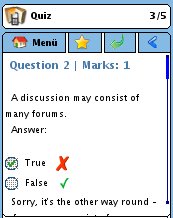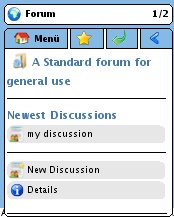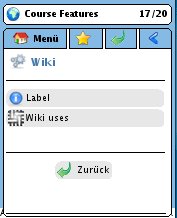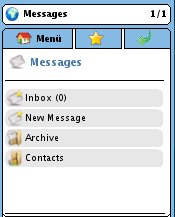Quizzes: A quiz tests, consists out of multiple choice, true-false, and short answer questions and more. Each attempt is automatically marked, and the teacher can choose whether to give feedback or to show correct answers.
A lesson consists out of multiple choices and each page ends with a question. The navigation through the lesson can be simple or complex and of course the Moodle Lessons work fully on the MLE. Create one learning content and use it for eLearning and mLearning.
You can submit an assignment or view the correction via the mobile phone. The assignments can be: upload files (audio/video/images) or plain text. Surveys and Choices: The Survey module provides a number of verified survey instruments that have been found useful in assessing and stimulating learning in online environments. It is fully functionaly on the MLE.
Forums: The Moodle forums are of course accessible through the mobile client. You can read and create / edit discussions and replies. Furthermore you are able to attach selfmade pictures, videos or audio recordings to your discussions and forum posts which you can instantly record with your phone or you can choose from the file system.
You can view the Moodle Wikis on the mobile phone.
A Moodle database is custom database which can be searched and displayed. Moodle Ressources: Of course you can access a variety of Moodle ressources on the mobile phone too, for example:
What is a flashcard trainer? A flashcard or flash card is a card that is used as a learning aid. One writes a question on a card and an answer overleaf. Flashcards can bear vocabulary, historical dates, formulas or any subject matter that can be learned via a question and answer format. Flashcards are widely used as a learning drill to aid memorization by way of spaced repetition. A widely used method to efficiently use flashcards was proposed by the German science popularizer Sebastian Leitner in the 1970s is used in this flashcard-trainer. In his method, known as the Leitner system, flashcards are sorted into groups according to how well you know each one. This is how it works: you try to recall the solution written on a flashcard. If you succeed, you send the card to the next group. But if you fail, you send it back to the first group. Each succeeding group has a longer period of time before you are required to revisit the cards. For example, suppose you have 3 groups called Group 1, Group 2 and Group 3. The cards in Group 1 are the ones that you often make mistakes with, and Group 3 contains the cards that you know very well. You might choose to study the Group 1 cards once a day, Group 2 every 3 days, and the Group 3 cards every 5 days. If you look at a Group 1 card and get the correct answer, you "promote" it to Group 2. A correct answer with a Group 2 card "promotes" that card to Group 3. If you make a mistake with a Group 2 or Group 3 card, it gets "demoted" to Group 1, which forces you to study that card more often. 
The advantage of this method is that you can focus on the most difficult flashcards, which remain in the first few groups. The result is, ideally, a reduction in the amount of study time needed.
You can even use the MLE-Editor to create mobile eBooks, which are optimized for a hugh amount of pages. You can view MLOs now (with the basic most common features) with your web-browser too, therefore you can use this content for both sides (mobile phone and PC).
The Moodle block "Online Users (mobile)" shows the Web users, who is online and who is currently online with a mobile phone. Furthermore you have full access to the contact and blocklist on the MLE and you can initiate phone calls, if the user has provided his phone number.
You can easily create tags which can be interpreted by the MLE (if your phone meets the requirements) or by any QR-Barcode Reader. Decoding a tag is as simple as taking a picture with your mobile phone. The integration of both creation and decoding capabilities of tags allows you to easily use this powerful feature in a great variatey of mobile learning scenarios, without the need of any external or third-party tools. The Mobile Tagging module allows different types of tags to be created. You can either create a tag linking to an URL, or Moodle specific tags directly forwarding the mobile user to a given course or activity. It is even possible to assign geo-information (coordinates) to a tag. This can be used to emulate GPS capabilities when real positioning is not available:
|




















































